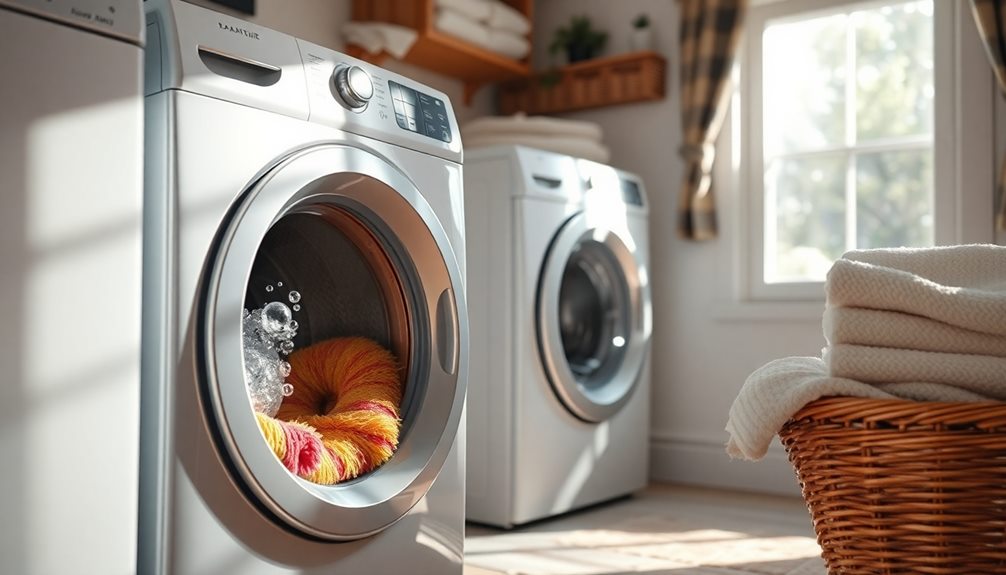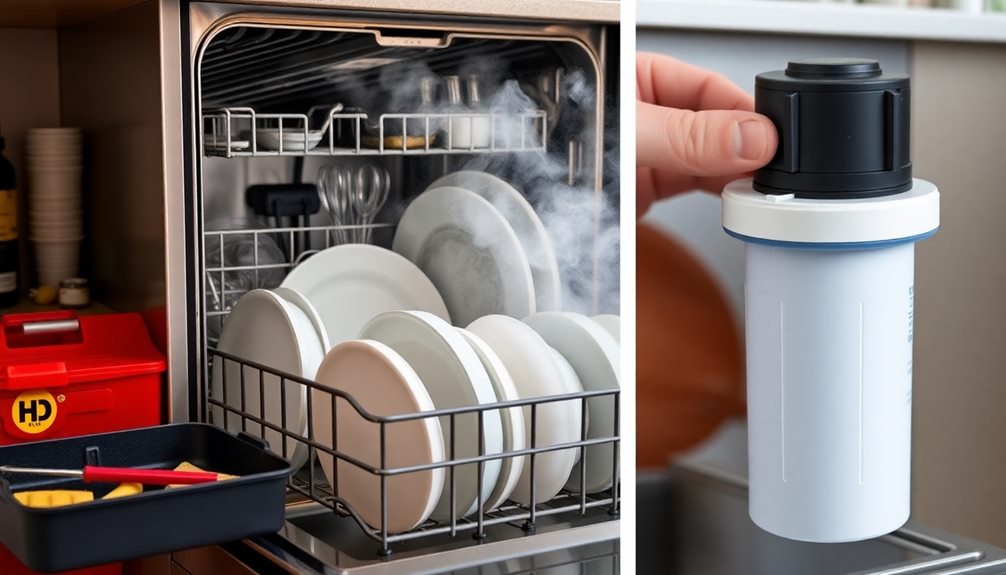To wash a rug in the washer without ruining it, first check the care label to verify it's machine washable. Remove loose dirt by vacuuming or shaking it outside. Use cold water and a gentle cycle with a mild detergent designed for rugs. Avoid using bleach or fabric softeners. For added care, load your rug with towels to prevent damage. After washing, air dry or tumble dry on low heat, avoiding high temperatures that can shrink or warp fibers. Following these steps helps keep your rug looking fresh, and you'll discover even more tips for effective cleaning next.
Key Takeaways
- Check the care label to confirm the rug is machine washable and follow specific washing instructions.
- Vacuum the rug thoroughly to remove loose dirt and prevent clogging the washing machine.
- Use cold water on a gentle cycle with a mild detergent designed for rugs or delicate fabrics.
- Avoid overloading the washing machine to ensure proper cleaning and rug movement.
- Air dry rubber-backed rugs and use low-heat settings for others to prevent damage.
Can Rugs Be Machine Washed?
When it comes to washing rugs, many homeowners wonder if their rugs can handle a trip through the washing machine. The answer largely depends on the materials used. Most machine washable rugs made from cotton or synthetic fibers like polyester and nylon are safe to toss in the washer.
However, you should always check the care label for specific instructions before proceeding. When you do wash them, use cold water and a gentle cycle to avoid any potential damage. It's a good idea to add towels to balance the load, especially in top-loading washers, ensuring even cleaning.
Be cautious with rugs that have rubber backs; frequent machine washing can deteriorate the backing material over time. You should avoid washing non-machine washable rugs, such as those made from wool, silk, or jute, as they can suffer irreversible damage.
Regular cleaning of machine-safe rugs helps maintain cleanliness and appearance, which contributes to their longevity and enhances your home's aesthetics. By following these guidelines, you can confidently keep your rugs looking fresh without the fear of ruining them.
Safe Tumble Drying Techniques
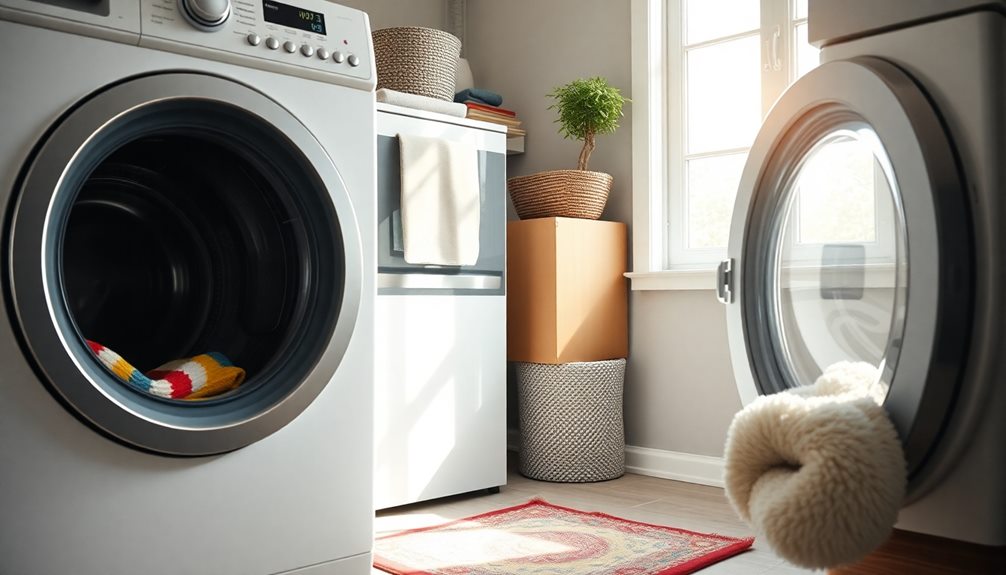
When you're ready to tumble dry your rug, always use low or cold settings to protect the fibers and extend its life.
If your rug has a rubber backing, skip the dryer altogether and air dry it instead.
Mixing towels in with your rug can help maintain an even load and prevent damage during drying.
Tumble Drying Settings
Tumble drying rugs can be a convenient option, but it's essential to use the right settings to protect their fibers and overall quality. Always set your dryer to low settings or use a no-heat setting to avoid damage. High heat can cause shrinkage and degrade the rug's fibers, so steer clear of that.
Before tossing your rug in, verify it's completely dry. Trapped moisture can lead to mold or mildew growth, which you definitely want to avoid.
If your rug has a rubber backing, it's best to air dry it instead of tumble drying, as frequent heat can deteriorate the backing over time.
Using the air-dry setting on your dryer is another great option. This will help maintain the shape and integrity of the rug while making sure it's free from excess moisture.
Remember, the goal is to protect your rug and keep it looking fresh for years to come. Following these safe tumble drying techniques will help you achieve just that.
Alternative Drying Methods
Maintaining the integrity of your rug requires careful consideration of drying methods, especially if you want to avoid damage from heat. While tumble drying can be safe, it's crucial to use low and cold settings. If you have rubber-backed rugs, skip the dryer altogether, as heat can compromise the backing.
For the best results, consider air drying the rug instead. Lay it flat in a well-ventilated area or hang it on a line. This method not only helps maintain the rug's integrity but also avoids the risk of uneven drying, which can lead to damage.
If you do opt for tumble drying, make sure to balance the load by adding towels. This prevents potential issues in the washer and promotes even drying.
Regardless of the method you choose, verify that the rug is completely dry before using it again. This precaution is crucial to prevent the growth of mold or mildew, which can ruin your rug and pose health risks.
Frequency of Rug Cleaning
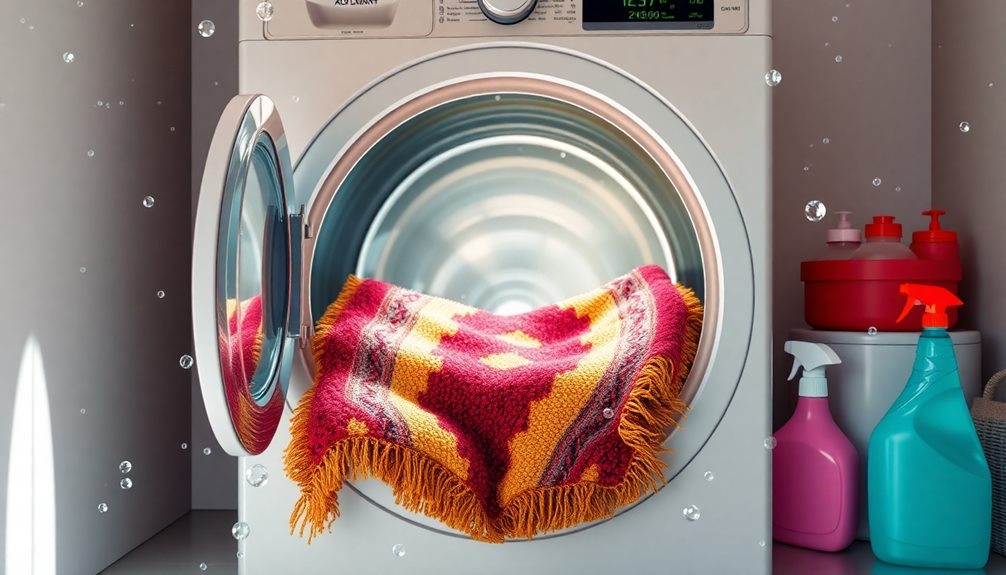
To keep your rugs looking fresh and free of dirt, it's essential to establish a regular cleaning schedule based on their location and usage. For rugs in high-traffic areas, aim for a washing frequency of every 6 to 12 months. This helps maintain cleanliness and prevent dirt buildup that can wear down your rug over time.
On the other hand, low-traffic rugs typically require washing every 12 to 18 months.
Regardless of traffic levels, immediate cleaning of spills is vital to avoid permanent stains. Don't wait for a scheduled wash if an accident happens; act right away!
Regular vacuuming at least once a week can also greatly reduce the need for frequent deep cleaning, keeping your rugs looking their best.
Always refer to the care label for specific recommendations regarding washing frequency and washing methods based on the rug material. Following these guidelines will help you effectively care for your rugs, ensuring they remain beautiful and functional for years to come.
Steps for Machine Washing Rugs
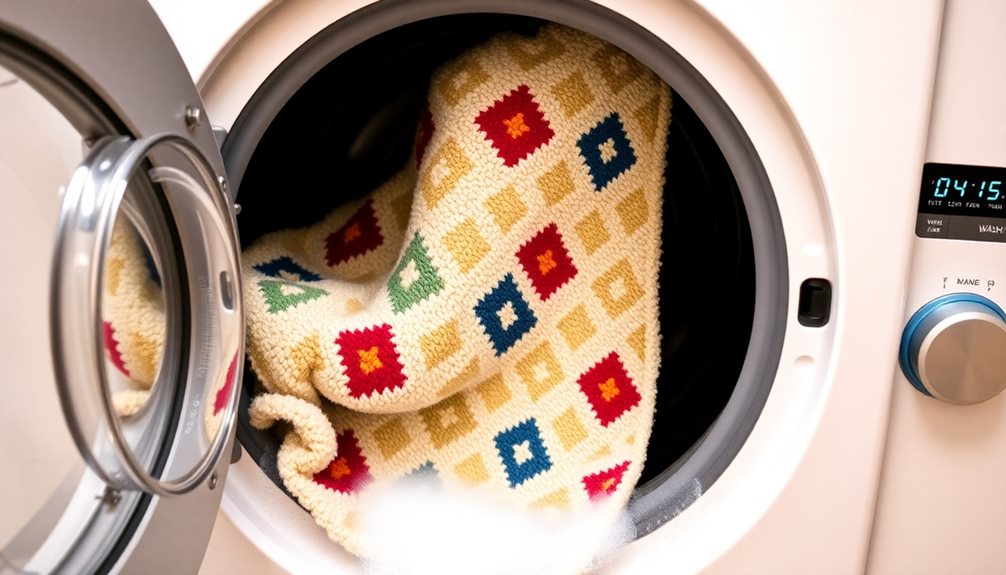
When you're ready to wash your rug in the machine, always start by checking the care label. This guarantees the rug is machine washable and helps you follow any specific washing instructions.
Next, shake the rug outside to remove loose dirt and debris, then vacuum both sides thoroughly. This step is essential for preventing clogging in your washing machine.
If you notice any major stains, treat them with a suitable stain remover before washing. When you load the rug into the washer, balance the load by adding towels if necessary.
Set your machine to a gentle or delicate cycle using cold water and mild detergent—avoid bleach and hot water, as they can damage the fibers.
Once the cycle is complete, it's important to air dry your rug. Lay it flat or hang it in a well-ventilated area to prevent shrinkage and preserve its shape.
Following these steps will help you effectively clean your rug while preventing damage, guaranteeing it stays looking great for years to come.
Cleaning Large Rugs Effectively
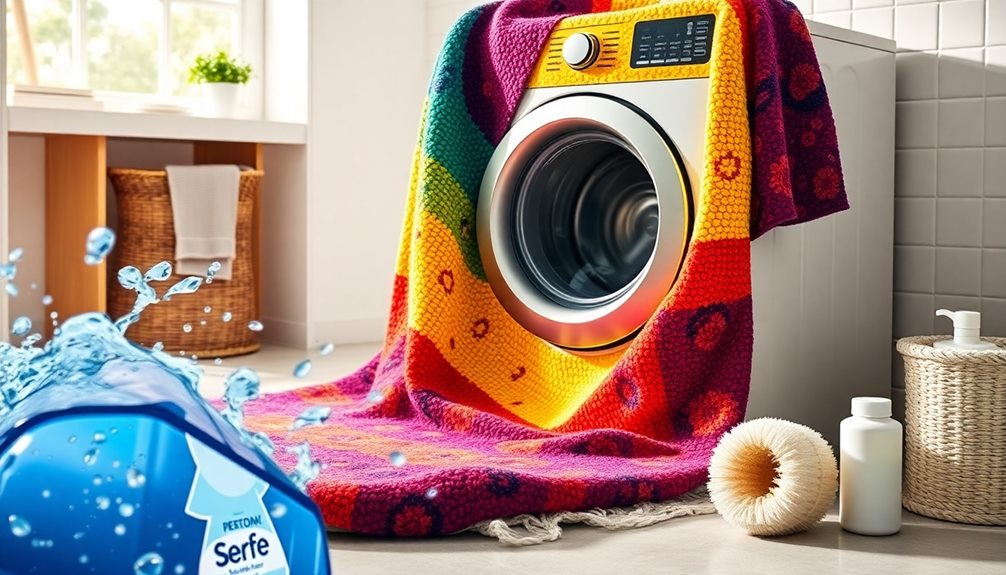
Cleaning large rugs effectively requires some strategic steps to guarantee a thorough job. Start by vacuuming both sides of the rug to remove dust and debris. This verifies you've eliminated as much dirt as possible before washing.
If you're cleaning outdoors, hose down the rug on a warm day to saturate it, which helps loosen dirt and grime.
Here's a quick checklist to follow:
- Use a plastic stiff brush to scrub in a suitable rug shampoo, focusing on heavily soiled areas.
- Rinse the rug thoroughly with water, verifying all shampoo and dirt are washed away. This prevents any residue that can attract more dirt later.
- After washing, use a squeegee to remove excess water, speeding up the drying process.
Machine Washable vs. Non-Washable Rugs
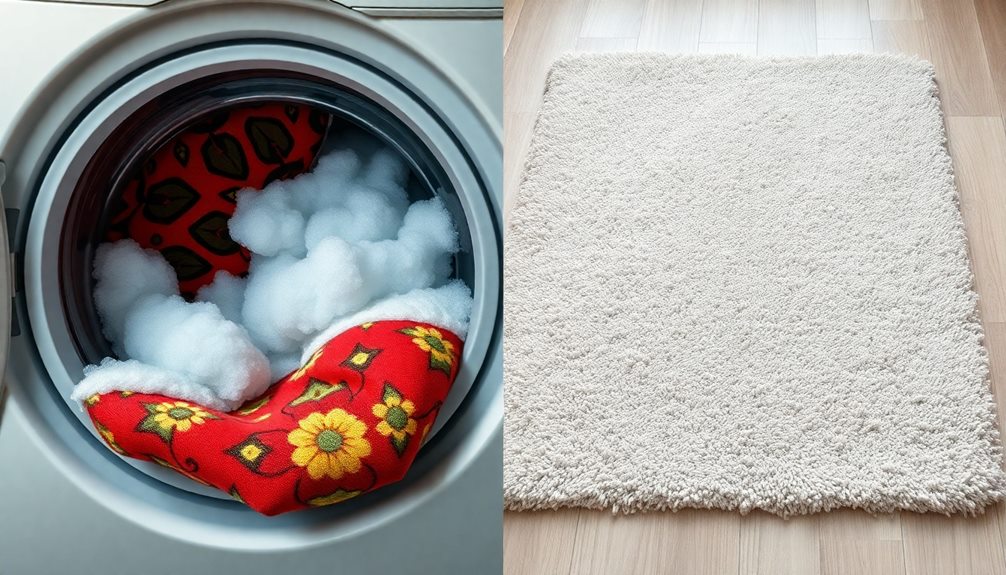
Understanding the difference between machine washable and non-washable rugs is vital for proper care and maintenance.
Machine washable rugs are typically made from durable materials like cotton, polyester, nylon, and microfiber. These synthetic fibers can withstand the rigors of a washing machine, helping you maintain cleanliness and appearance with regular washes.
On the other hand, non-machine washable rugs often feature delicate materials such as wool, silk, and natural fibers like jute and sisal. These materials can easily be damaged or deteriorate when exposed to moisture, which is why it's important to check the care label before washing.
If your rug is non-machine washable, you'll likely need to invest in professional cleaning to keep it in good shape.
To avoid damage, always be cautious with antique or hand-knotted rugs, as they require extra care.
To sum up, knowing the rug materials and their washing capabilities can save you from costly mistakes and help you keep your rugs looking their best.
Make sure to read those care labels carefully!
Dos and Don'ts of Rug Washing
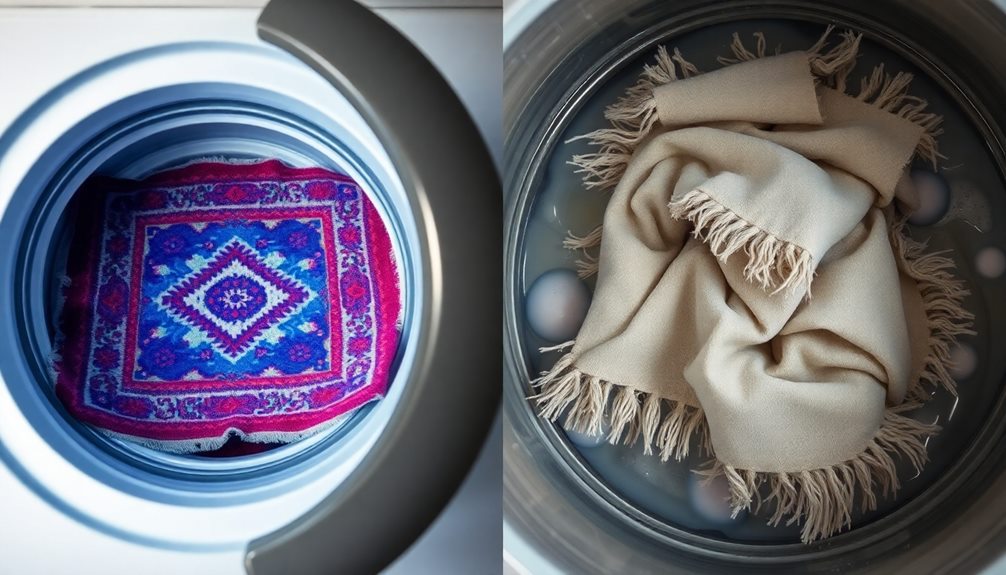
Knowing whether your rug is machine washable or not sets the stage for effective cleaning. Once you confirm that it can be washed, follow these dos and don'ts to guarantee a successful wash without ruining it.
Dos:
- Do check the manufacturer's label for specific washing instructions. This guarantees you follow the correct guidelines for the rug's material.
- Do vacuum the rug thoroughly before washing. This removes dirt and debris, preventing clogs in the washing machine and promoting a more effective clean.
- Do use mild detergent and cold water. This protects the fibers and preserves the rug's color, avoiding shrinkage or damage.
Don'ts:
- Don't overload the washing machine. Make sure there's enough space for the rug to move freely, allowing for an even wash.
- Don't use hot water, bleach, or harsh chemicals. These can degrade the fibers and cause discoloration, ultimately ruining the rug's integrity.
Best Practices for Rug Maintenance
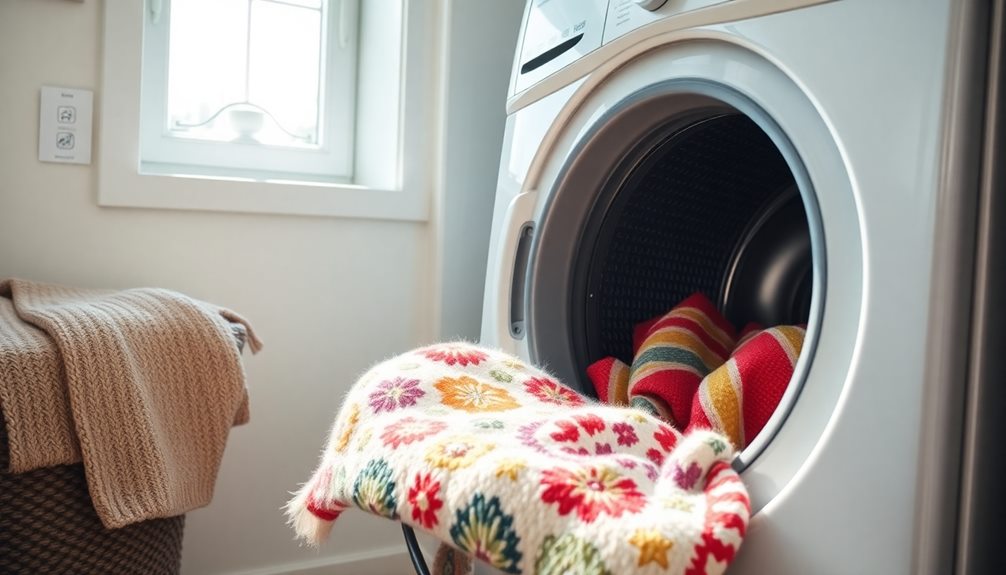
To keep your rug looking its best, you should stick to a regular vacuuming schedule, ideally at least once a week.
Don't wait to treat stains; addressing spills immediately can save you from permanent marks.
Additionally, using proper storage techniques when you're not using the rug can help maintain its shape and quality.
Regular Vacuuming Schedule
A consistent vacuuming schedule is crucial for maintaining the beauty and longevity of your rugs. Regular vacuuming helps prevent dirt and dust buildup, which can lead to wear and tear over time.
As a rug enthusiast, you'll want to keep your rugs looking pristine and prolong their lifespan. Here are some best practices to follow:
- Vacuum at least once a week to maintain cleanliness and appearance.
- For high-traffic areas, consider vacuuming every 3-4 days to effectively remove embedded dirt and debris.
- Always use a vacuum cleaner with a beater bar or brush attachment for deeper cleaning.
Don't forget to vacuum both sides of the rug! This guarantees thorough cleaning, eliminating dust that may accumulate underneath.
By sticking to a regular vacuuming schedule, you'll not only enhance your rug's aesthetic but also protect it from potential damage caused by settled dirt.
Immediate Stain Treatment
Even with a regular vacuuming schedule, accidents can happen, and spills are an inevitable part of life. When a spill occurs, it's essential to act quickly for effective immediate stain treatment. Start by blotting with a clean, white cloth to absorb excess liquid. This simple step can greatly prevent stains from setting into the fibers.
Next, use a suitable cleaning solution tailored to the type of stain and rug material. Apply it gently to avoid causing any discoloration or damage. Before using any stain removal products, always test them on a small, inconspicuous area of your rug first. This precaution helps guarantee the products won't harm your rug.
For persistent stains, let the cleaning solution sit for a few minutes, then blot again with a clean cloth to lift the stain effectively.
Remember, regular vacuuming not only maintains your rug's appearance but also helps reduce dirt buildup, making stain removal easier when accidents occur.
Proper Storage Techniques
Proper rug storage is essential for maintaining its beauty and longevity. To guarantee your rugs stay in top condition, follow these best practices:
- Store rugs in a cool, dry place. Rolling them up is better than folding, as it prevents creases and helps maintain their shape.
- Use breathable storage bags or wrap rugs in cotton sheets to protect them from dust and moisture while allowing air circulation.
- Avoid direct sunlight to prevent fading and deterioration of colors and fibers.
Additionally, make it a habit to conduct periodic inspections of your stored rugs. Check for signs of pests or mildew; catching these issues early can save you from severe damage.
If you plan to store your rugs for an extended period, consider rotating them every few months. This practice helps guarantee even wear and prevents permanent indentations from forming.
Common Rug Washing Mistakes
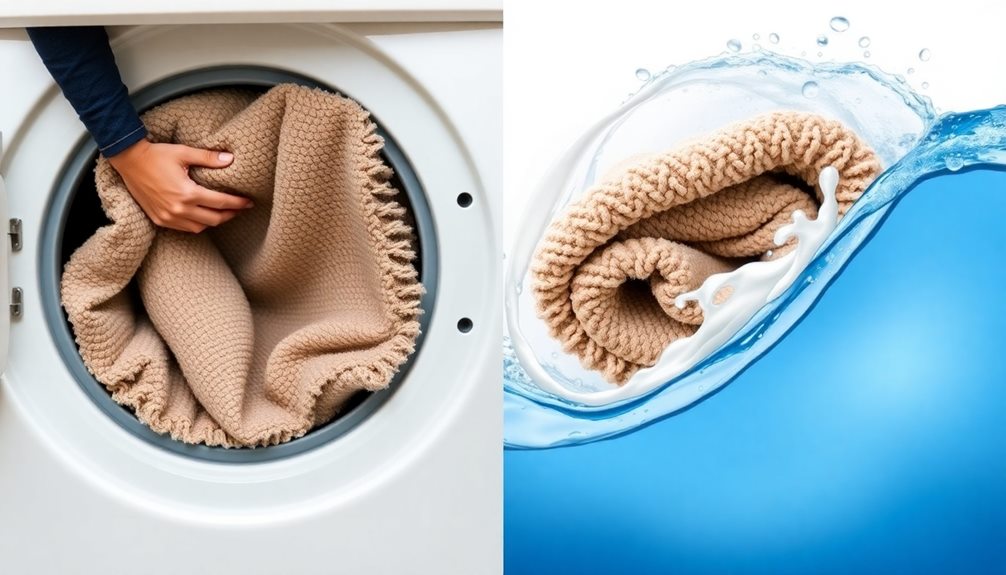
When washing a rug, it's easy to make mistakes that can lead to damage or ineffective cleaning. To guarantee your rug stays in great condition, here are some common pitfalls to avoid.
| Mistake | Consequence | Solution |
|---|---|---|
| Overloading the washing machine | Prevents even cleaning and may damage the rug | Leave enough space for the rug to move freely |
| Using hot water | Causes shrinkage and damages fibers | Always use cold water |
| Skipping vacuuming | Leads to clogs and ineffective cleaning | Vacuum the rug before washing |
Additionally, avoid using harsh products like bleach, as they can ruin the fibers. Always check the care label for specific washing instructions; some rugs may not be machine washable. Also, don't use fabric softeners, as they can leave residues that attract dirt and make it harder to remove stains. Remember, washing is the monster if you don't take the right precautions. By following these tips, you can effectively clean your rug without causing harm.
Additional Resources for Rug Care
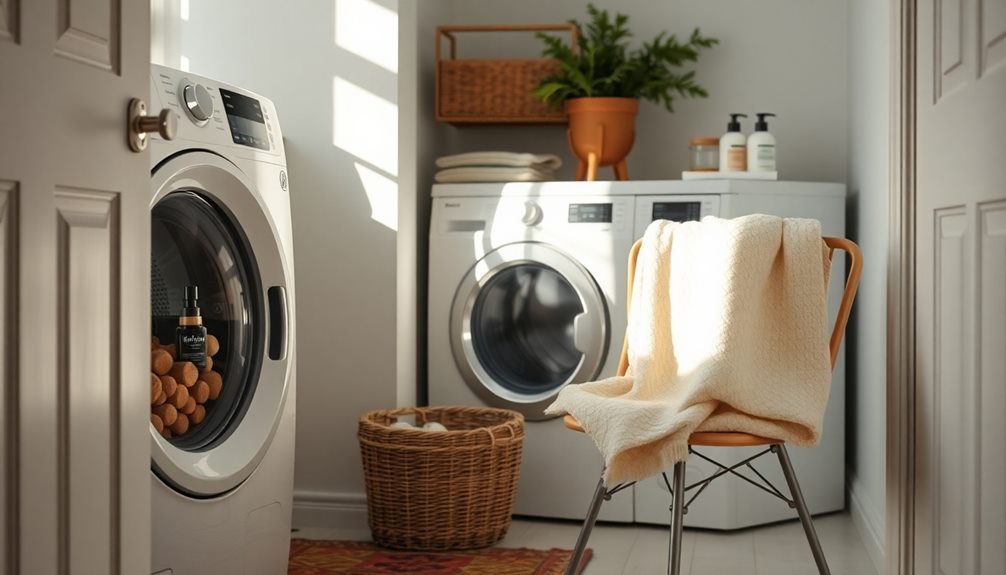
When caring for your rug, always start by checking the care label for specific washing instructions.
You should also familiarize yourself with effective stain treatment techniques and preferred drying methods to keep your rug looking its best.
These resources will help you maintain your rug's appearance and longevity.
Care Label Importance
While you might be keen to toss your rug into the washing machine, the care label is your best guide for guaranteeing it stays in great shape.
This label contains essential information about how to clean your rug properly, helping you maintain its appearance and integrity over time. Ignoring it could lead to damage, such as shrinkage or fading.
Here are three key points to check on your care label:
- Machine Washable: Confirm your rug is suitable for machine washing before you proceed.
- Washing Cycle & Water Temperature: Follow the recommended washing cycle and water temperature to avoid harming the fibers.
- Suitable Detergents: Use only the detergents specified to prevent deterioration of materials.
Stain Treatment Techniques
Effective stain treatment techniques are vital for keeping your rug looking its best. When you encounter fresh spills, act quickly—blot the area with a clean white cloth to absorb excess liquid without rubbing, which could spread the stain.
For spot cleaning, use a mixture of mild detergent and cold water. Adding a few drops of lavender oil can also help neutralize odors while providing a calming scent. Apply this solution gently to the stain, then blot until the stain begins to lift. Rinse the area with clean water afterward to remove any residue.
If you face tough stains that won't budge, consider using an oxygen-based bleach as a last resort. Always test this on a discreet area of your rug first to verify colorfastness and compatibility with the material.
Regular vacuuming is equally important; it helps remove dirt and debris that can lead to discoloration and set stains.
Drying Methods Preferences
After washing your rug, choosing the right drying method is crucial for maintaining its quality and appearance. Air drying is your best bet, as it helps prevent shrinkage and preserves the fibers' integrity. Machine drying, especially for rubber-backed rugs, can lead to irreversible damage.
Here are some tips to guarantee proper drying:
- Lay your rug flat or hang it in a well-ventilated area to promote even drying and prevent mildew growth.
- Avoid direct sunlight, as prolonged exposure can cause colors to fade and weaken fibers.
- If the care label allows for tumble drying, use a low-heat setting to extend your rug's lifespan and prevent damage.
Always check the care label for specific drying recommendations, as some materials may have unique requirements.
Following these guidelines will help you keep your rug looking fresh and vibrant for years to come. Remember that the right drying method not only prevents shrinkage but also enhances the overall longevity of your rug.
Frequently Asked Questions
Can I Wash a Rug in the Washing Machine?
You can wash a rug in the washing machine, but first, check its care label. If it's cotton or synthetic, you're usually good to go. Just remember to use cold water and a gentle cycle.
Can I Put a Rug With a Rubber Back in the Washing Machine?
As the saying goes, "An ounce of prevention is worth a pound of cure." You can put a rug with a rubber back in the washing machine, but check the care label and use cold, gentle cycles.
How Do You Clean a Rug Without Damaging It?
To clean a rug without damaging it, start by vacuuming thoroughly. Check the care label, and if machine washable, use a gentle cycle with cold water. Always air dry to maintain its shape and color.
How Do You Clean a Rug Without Putting It in the Washing Machine?
Imagine your rug as a cherished treasure. To clean it without a washing machine, vacuum both sides, spot clean stains, hand-wash with a mild solution, or hire professionals for delicate care. You've got this!
Conclusion
To keep your rugs looking radiant and resilient, remember these washing wisdoms: Always check for care labels and test for colorfastness before tossing them in the washer. With proper preparation and the right techniques, you can successfully scrub away stains without sacrificing style. Regular maintenance and mindful methods will guarantee your rugs remain a beautiful backdrop in your home. So, stay savvy, and your rugs will reward you with lasting loveliness!
